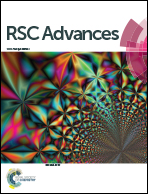Impact of different nanostructures of a PEDOT decorated 3D multilayered graphene foam by chemical methods on supercapacitive performance†
Abstract
The present research article describes chemically grown different nanostructures of poly(3,4-ethylenedioxythiophene) (PEDOT) on porous multilayered graphene foam (PEDOT/3D GF) as a supercapacitor electrode material with enhanced electrochemical performance. Different nanostructures of PEDOT on 3D GF are synthesised by a chemical method using an EDOT monomer as a precursor along with ammonium persulfate (APS) or iron chloride (FeCl3) as an oxidizing agent. The changes in structural, morphological and electrochemical properties are examined as an impact of different oxidizing agents. Structural and morphological analysis reveals uniform growth of PEDOT nanofibers/nanoparticles over 3D GF. The morphological development of nanofibers and nanoparticles over the graphene foam is observed as an influence of the oxidizing agent. The electrochemical capacitive measurements of the PEDOT/3D GF electrode in 1 M H2SO4 exhibits a high specific capacitance of ∼522 F g−1 and ∼88 F g−1 at 2 mA cm−2 current density for nanofibers and nanoparticle like structures, respectively. A wide porous structure, excellent conductivity and high surface area offered by multi-layered graphene framework arouses effective utilization of the deposited PEDOT with improved electrochemical charge transport and also storage capacity.


 Please wait while we load your content...
Please wait while we load your content...